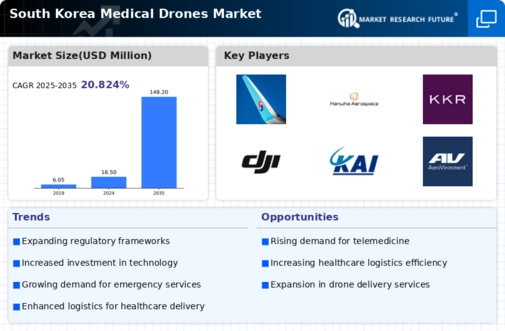The South Korea Medical Drones Market has gained significant attention and traction in recent years, fueled by advancements in drone technology and the increasing demand for efficient medical logistics solutions. The competitive landscape in this market is dynamic, with various companies vying for a leadership position by leveraging innovative technologies, operational efficiencies, and strategic partnerships. The deployment of drones for medical deliveries, especially in rural and hard-to-reach areas, has enhanced healthcare accessibility, reduced delivery times, and streamlined supply chains.
As the market continues to expand, companies are competing not only through product offerings but also by addressing regulatory challenges, ensuring safety and reliability, and developing robust infrastructure to support drone operations. In this competitive environment, collaboration with governmental and healthcare institutions has become crucial for establishing trust and fostering sustainable growth within the sector. Korean Air stands as a formidable player in the South Korea Medical Drones Market, heavily invested in the development of advanced aerial logistics for medical applications.
The company's strengths lie in its established infrastructure, extensive experience in aviation, and commitment to innovation in drone technology. Korean Air has been focusing on developing drones equipped with advanced navigation systems, payload delivery mechanisms, and autonomous operation capabilities, making them highly suitable for medical deliveries. The company’s long-standing expertise in logistics and transportation plays a vital role, as it already has a comprehensive network that can facilitate swift and efficient distribution of medical supplies, vaccines, and emergency shipments across the country.
Furthermore, Korean Air's proactive approach in partnering with healthcare providers underscores its commitment to improving patient outcomes and healthcare efficiency through technological advancements in the drone segment. Hanwha Aerospace is another key contender in the South Korea Medical Drones Market, known for its strategic initiatives and innovative projects aimed at enhancing medical drone logistics. The company's offerings include technologically advanced drone platforms capable of transporting medical devices, pharmaceuticals, and biological samples.
With a focus on improving healthcare logistics, Hanwha Aerospace has been engaged in collaborations that leverage its engineering expertise to strengthen operational capabilities in the medical drone sector. The company also emphasizes research and development, allowing it to stay ahead in terms of technological advancements. Recently, Hanwha Aerospace has explored potential mergers and acquisitions to diversify its product range and strengthen its market position, reflecting a strategic vision aligned with industry demands. This proactive market presence, coupled with its technical strengths, positions Hanwha Aerospace as a significant player in reshaping the future of medical delivery in South Korea.







